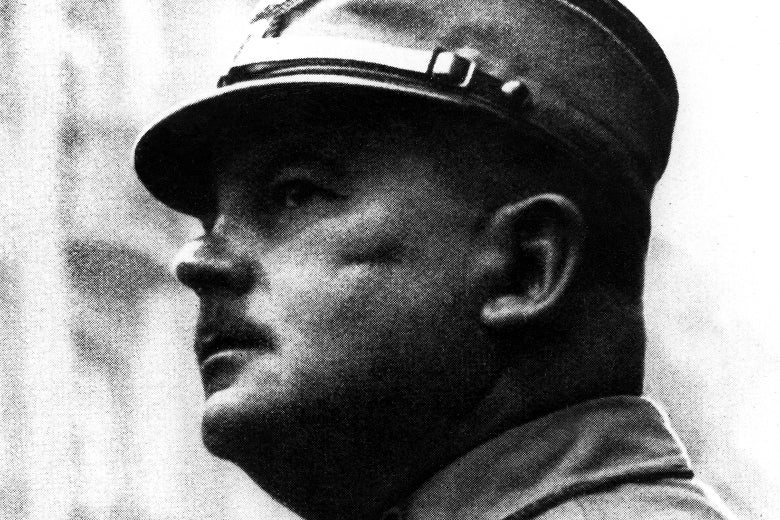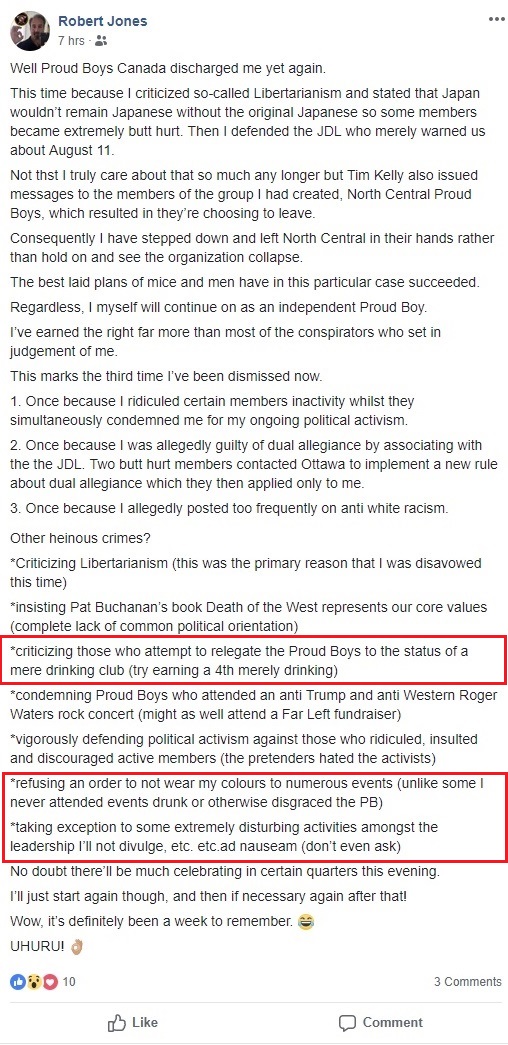Why the Myth of the “Gay Nazi” Is Back in CirculationAnd why, in the face of thousands of queer murders at the hands of Hitler, it’s still absurd.By LAURIE MARHOEFER
AUG 24, 201810:44 AM Ernst RöhmArchiv Gerstenberg/ullstein bild via Getty Images
Ernst RöhmArchiv Gerstenberg/ullstein bild via Getty ImagesThe myth of the “gay Nazi,” I’m sorry to report, is back.
In a new film praised by Donald Trump Jr. (as well as in his 2017 book), Dinesh D’Souza claims that Hitler was an LGBTQ ally. Supposedly this demonstrates a big similarity between the Nazis and the current Democratic Party in the United States. This entire notion is absurd. But it’s worth asking why D’Souza was even able to float this wacky allegation in the first place. How is it possible to claim that Hitler, the person responsible for modern history’s bloodiest crackdown on homosexuality, was a gay rights supporter?
Like all dangerous lies, the myth of the gay Nazi is wrapped around a grain of reality. There was a closeted gay man in the early Nazi Party. He wasn’t a myth, and Hitler had him killed in 1934—in part, ostensibly, because he was gay.
What’s a myth is that we ought to talk only about him, and not about the thousands of other men the Nazis murdered for homosexuality. The underlying flawed, homophobic assumption is that a single famous closeted gay Nazi means there was something queer about fascism—despite the millions of heterosexual Nazis, and despite the fact that German fascists murdered more queers than any other modern regime.
If you only remember one thing about Nazi Germany and homosexuality, let it be this: On Hitler’s orders, the Nazis murdered 5,000 or more men for the “crime” of having sex with another man. Tens of thousands of other men were convicted of “sodomy” but not murdered. They did not get off easy: Some were forced to undergo castration. Queer Jewish victims of the Nazis suffered homophobia and had their histories erased. The violence engulfed people we’d now identify as trans women, too: They were often branded homosexual by Nazi officials, and a separate law banned cross-dressing. Lesbians and people we’d call trans men often—though not always—escaped prison or the camps, but they, too, were at risk.
In other words: Hitler was not pro-queer.
But what’s the truth about that famous gay Nazi? Before Hitler became chancellor, Germany was a democracy with a robust gay rights movement. In the 1920s, gay activists nearly got Parliament to repeal the sodomy law. (The United States did not strike down its sodomy laws until 2003.) For most of this period the nascent Nazi Party was tiny and marginal, campaigning for seats in Parliament just like all the other political parties.
Nazi ideology was zealously anti-gay, and the Nazis wanted no part of “homosexual emancipation,” as the gay rights movement called itself. At one point, one of the gay rights groups wrote to the Nazis and asked their position on homosexuality. The response was: “Anyone who even thinks of homosexual love is our enemy.” Nazi propaganda accused Jews of spreading homosexuality in an effort to destroy Germany.
When the Nazis took power in 1933 and turned the democracy into a dictatorship, they revised the existing law against sodomy and made it much harsher. “Unfortunately, we don’t have it as easy as our forefathers,” a top Nazi lamented in 1937. Back then, he went on, “the homosexual … was drowned in a swamp, clothes and all. That wasn’t a punishment, but simply the extinguishing of abnormal life. It had to be got rid of, just as we pull out weeds, throw them on a heap, and burn them.”
In other words: Hitler was not pro-queer.
Despite all this violently aggressive heterosexuality, in the years before Hitler took power, anti-fascists started to claim the Nazis were gay. It was a way to attack them. For example, social democratic journalists in Munich charged that the Nazis were hypocrites because they tolerated “the shameless practice of sodomy in [their] own ranks.” The accusations centered on one man: Ernst Röhm.
Röhm was one of Hitler’s right-hand guys. He was also privately homosexual. He hid his affairs with men from most of the people in his life, including Hitler and other Nazis. But when the Great Depression hit and the tiny Nazi Party suddenly started winning elections, Röhm became famous. Someone who knew his secret did not like fascism, and they went to the press.
The Röhm scandal boiled over in 1932, the year before Hitler took power. Social Democrats, who were in cahoots with the police, got hold of actual letters Röhm had written to a friend. They published them. In the letters, Röhm described his desires for men. Shortly after the pamphlet containing the letters came out, the anti-fascist journalist who published them ran into one of Röhm’s thug lieutenants in the café in the Parliament building, of all places. The lieutenant went up to the anti-fascist journalist and slapped him. Other Nazis joined in; one struck the journalist with a chair. The ensuing brawl shut down Parliament and made the front pages of the papers the next day. After that, there were few people left in Germany who did not know that Röhm was supposedly a homosexual.
Though other Nazis pleaded with Hitler to fire Röhm, Hitler brushed the scandal off. The rest of the leadership was dismayed. An important Nazi ally remarked that in the old days, one would have handed a man in Röhm’s position a gun so that he could shoot himself. Hitler did not—at least, not yet.
Did Hitler stand by Röhm because he was some kind of LGBTQ ally? No. He kept Röhm because it was the politically expedient thing to do. He thought he was on the brink of taking power, and he needed Röhm’s connections to the army. Moreover, there was no downside to keeping Röhm. Hitler guessed the public’s mood correctly, as he often did. People did not much care about Röhm’s sex life. Before the Nazi seizure of power, Germany was a pretty open and tolerant place when it came to homosexuality, especially the private homosexuality of an otherwise respectable person. Hitler was not striking out boldly in favor of gay rights. He was, rather, going with the flow.
The scandal died down. The Nazis continued to win big at the polls. They become the largest party in Parliament. The democratic system fell into its death throes. Hitler did, however, eventually have Röhm shot.
In 1934, Hitler, now a dictator, ordered the murders of Röhm and a host of other people in a purge called “The Night of the Long Knives.” Though the motives were political, afterward Hitler claimed he had done it to protect Germany from homosexuality. The state-controlled press reported that Röhm had planned to overthrow Hitler. The press also claimed that when Hitler’s men arrived to arrest Röhm and his deputies, they found one of them in a “disgusting situation” with a boy. As one of the country’s leading newspapers, the Völkischer Beobachter (People’s Observer), put it, “The Führer gave the order that the pestilence be ruthlessly washed away. In the future he will no longer tolerate the molestation and compromising of millions of respectable people by a single person with a sick orientation.”
Despite the body count in Nazi Germany—not to mention in Nazi-occupied Europe—of men killed for having sex with other men, for many years the left kept up its campaign to paint the Nazis as secretly gay. The idea that fascism was queer fed on a neighboring anti-gay theme: that queer people are so morally disordered that they like chaotic violence, too.
Lots of people still believe there was something queer about fascism. They conveniently use the story about Röhm to erase fascism’s murderously heterosexual nature. Röhm’s story is a fascinating one, and yes, some—though not very many—fascists were queer (people of all political persuasions have queer sex). But let’s not only talk about Röhm. D’Souza’s book does not even mention the 50,000 sodomy convictions and 5,000 or more murders.
The reason this myth is circulating now is that the Republican Party has lurched to the far right and homo- and transphobia is in style. Equating fascism with homosexuality gets the right off the hook—right-wingers are against homosexuality, so they can’t be fascists. It makes gay men responsible for fascism, and therefore dangerous and loathsome. At the same time, it erases the history of violence against gay men carried out in the name of a sodomy law.
The logic here is twisted to be sure, but when one follows it, gay rights seems dangerous, rolling back gay rights seems perhaps a good idea, and sodomy laws don’t seem so odious. If that sounds hyperbolic, recall that the Republicans just ran a candidate for Senate in Alabama who wanted to bring back sodomy laws. Roy Moore lost, but not before the Republican president endorsed him. The same president likes D’Souza, too. That’s probably not a coincidence.









